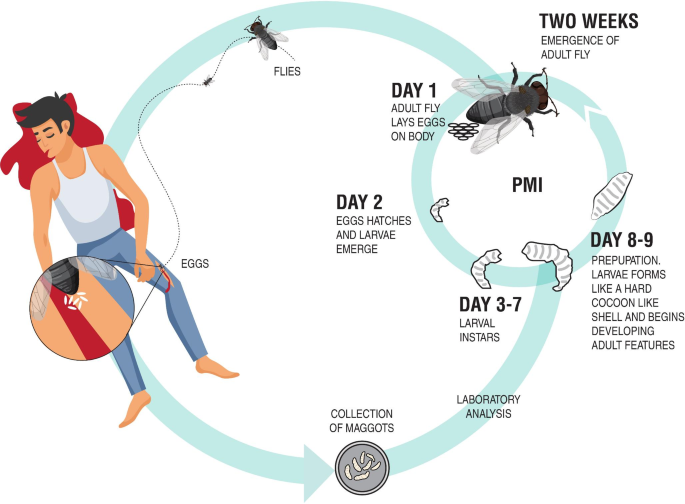Introduction
Forensic entomology, an intriguing branch of forensic science, provides invaluable insights into criminal investigations. Among its many applications, one of the most compelling is its ability to determine crime scene relocation using insect evidence. This process involves analyzing the presence, development, and succession of insects on decomposing remains to infer whether a body has been moved postmortem. This article delves into the science of forensic entomology, the methodologies used in analyzing insect evidence, and real-world case studies that highlight its significance in solving crimes.
Forensic Entomology: An Overview
Forensic entomology is the study of insects and other arthropods in the context of legal investigations. It focuses on the relationship between insects and decomposing remains, providing critical information such as the postmortem interval (PMI), the time elapsed since death. By studying insect colonization patterns, forensic entomologists can determine the conditions and timelines of a crime scene.
Key Insects in Forensic Investigations
Different species of insects are attracted to decomposing remains at various stages of decomposition. The primary insects involved in forensic investigations include blowflies (Calliphoridae), flesh flies (Sarcophagidae), and beetles (Coleoptera). Each species has a unique life cycle and colonization pattern, making them valuable indicators of PMI and potential crime scene relocation.
Blowflies
Blowflies are often the first insects to arrive at a decomposing body, usually within minutes to hours after death. They lay eggs in natural body openings and wounds, and their larvae (maggots) feed on the decaying tissues. The presence and developmental stage of blowfly larvae can provide crucial information about the time since death.
Flesh Flies
Flesh flies, like blowflies, are attracted to decomposing remains and lay their larvae directly on the body. The larvae develop rapidly, and their presence can be used to estimate the PMI. Flesh flies are particularly useful in determining whether a body has been moved, as they are highly sensitive to changes in environmental conditions.
Beetles
Beetles, including carrion beetles and rove beetles, arrive at a body during later stages of decomposition. They play a significant role in breaking down the remains and can provide valuable information about the conditions and timeline of a crime scene.
Insect Succession Patterns
The process of insect colonization on decomposing remains follows a predictable pattern, known as insect succession. This pattern is influenced by various factors, including temperature, humidity, and the location of the body. By studying the succession patterns, forensic entomologists can determine whether a body has been moved from its original location.
Determining Crime Scene Relocation
Crime scene relocation refers to the movement of a body from the site of death to another location. This can be done for various reasons, including concealing the crime, misleading investigators, or disposing of the body. Forensic entomologists play a crucial role in identifying crime scene relocation by analyzing insect evidence.
Analyzing Insect Evidence
The analysis of insect evidence involves collecting samples from the body and the surrounding environment. Forensic entomologists examine the species, developmental stages, and abundance of insects present. By comparing these findings to known insect succession patterns, they can make inferences about the conditions and timeline of the crime scene.
Techniques and Methods in Forensic Entomology
To effectively analyze insect evidence and determine crime scene relocation, forensic entomologists employ a range of techniques and methodologies:
Collection of Insect Samples
Insect samples are collected from the body and the surrounding environment during crime scene investigations. These samples include both adult insects and larvae, which are crucial for accurate analysis. Proper collection and preservation techniques are essential to maintaining the integrity of the evidence.
Species Identification
Identifying the species of insects present on the decomposing remains is a fundamental step in forensic entomology. Each species has a specific colonization pattern and developmental timeline, which can provide valuable information about the PMI and potential crime scene relocation.
Developmental Stage Analysis
Forensic entomologists analyze the developmental stages of insect larvae to estimate the PMI. This involves measuring the size and age of the larvae, which can be compared to known growth rates for the species. By determining the age of the larvae, forensic entomologists can infer the time since death and whether the body has been moved.
Environmental Conditions Assessment
Environmental conditions, such as temperature, humidity, and geographic location, play a significant role in insect colonization and development. Forensic entomologists assess these conditions to understand how they may have influenced the insect activity on the body. Changes in environmental conditions can indicate whether the body was moved from one location to another.
Comparison with Control Data
Forensic entomologists often compare their findings with control data, which includes known insect succession patterns and developmental timelines for specific species. This comparison helps validate the conclusions drawn from the insect evidence and provides a scientific basis for determining crime scene relocation.
Real-World Case Studies
Case Study 1: The Forest Discovery
In one notable case, a body was discovered in a forested area with extensive insect activity. Forensic entomologists identified blowfly larvae in advanced developmental stages, suggesting that the body had been dead for several days. However, the absence of certain beetle species, which would typically be present at this stage, indicated that the body had been moved to the forest postmortem. This information helped investigators narrow down the original crime scene and ultimately identify the perpetrator.
Case Study 2: The Urban Abandonment
In another case, a body was found in an abandoned urban building with an abundance of flesh fly larvae. The developmental stage of the larvae suggested that the body had been dead for a shorter period than initially believed. Further analysis revealed that the body had been moved from a different location, as the environmental conditions of the building did not match the insect evidence. This led investigators to the original crime scene, resulting in the arrest and conviction of the suspect.
Case Study 3: The Riverbank Mystery
A body discovered near a riverbank presented a unique challenge for forensic entomologists. The presence of aquatic insects and larvae suggested that the body had been submerged in water for some time. However, the presence of terrestrial insects at various developmental stages indicated that the body had been moved to the riverbank after initial decomposition. This evidence provided critical insights into the timeline and sequence of events, aiding investigators in solving the case.
Challenges and Limitations
While forensic entomology is a powerful tool in criminal investigations, it is not without its challenges and limitations. Factors such as temperature, humidity, and weather conditions can significantly impact insect colonization patterns, making it difficult to draw accurate conclusions. Additionally, the presence of chemicals or toxins can alter insect behavior and development, complicating the analysis.
Environmental Factors
Environmental factors play a critical role in insect colonization and development. Temperature is one of the most significant factors, as it directly affects the rate of insect development. High temperatures can accelerate development, while low temperatures can slow it down. Humidity levels also influence insect activity, with high humidity promoting faster colonization.
Chemical Interference
The presence of chemicals or toxins, such as insecticides or drugs, can interfere with insect behavior and development. This can complicate the analysis, as the expected insect succession patterns may be altered. Forensic entomologists must consider these factors when interpreting the evidence and drawing conclusions.
Case Study: Chemical Interference
In a notable case, a body was discovered with limited insect activity, despite being in a location conducive to insect colonization. Forensic entomologists found traces of insecticides on the body, which had inhibited insect development. By identifying the chemicals present, investigators were able to understand the altered insect behavior and estimate the PMI more accurately. This case highlighted the importance of considering chemical interference in forensic entomology analyses.
Future Directions and Technological Advancements
As forensic science continues to evolve, advancements in technology and research are enhancing the field of forensic entomology. New tools and methodologies are being developed to improve the accuracy and reliability of insect evidence analysis.
Genetic Analysis
Genetic analysis techniques, such as DNA barcoding, are increasingly being used to identify insect species with greater precision. This allows forensic entomologists to differentiate between closely related species and gain more accurate insights into the PMI and crime scene relocation.
Remote Sensing Technology
Remote sensing technology, including drones and satellite imagery, is being explored for its potential to assist in crime scene investigations. These technologies can provide valuable information about the environmental conditions and geography of a crime scene, aiding forensic entomologists in their analyses.
Artificial Intelligence and Machine Learning
Artificial intelligence (AI) and machine learning algorithms are being developed to analyze insect evidence and predict insect colonization patterns. These technologies have the potential to streamline the analysis process, reduce human error, and provide more accurate estimations of PMI and crime scene relocation.
Conclusion
Forensic entomology is an invaluable tool in criminal investigations, particularly in cases involving crime scene relocation. By analyzing insect evidence, forensic entomologists can determine whether a body has been moved, estimate the postmortem interval, and provide critical information to investigators. While there are challenges and limitations, the meticulous study of insect colonization patterns continues to advance our understanding of decomposition and enhance the accuracy of forensic analyses. As forensic science evolves, the role of forensic entomology in solving crimes will undoubtedly become even more prominent, contributing to the pursuit of justice and the resolution of complex cases. With ongoing technological advancements and research, the future of forensic entomology holds great promise in further unraveling the mysteries of crime scene investigations.

